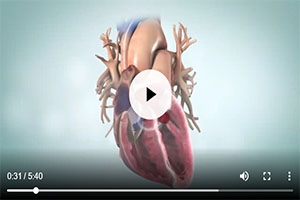Electrophysiology
 OSF HealthCare Cardiovascular Institute offers a variety of innovative services to evaluate and correct the electrical function of pediatric and adult hearts.
OSF HealthCare Cardiovascular Institute offers a variety of innovative services to evaluate and correct the electrical function of pediatric and adult hearts.
Learn more about cardiac arrhythmia problems
Catheter Ablation
A procedure that uses small wires threaded to the heart to eliminate part of an abnormal electrical pathway in the heart that is causing an abnormal heart rhythm or arrhythmia.
Cardiac Resynchronization Therapy
Cardiac Resynchronization Therapy involves the placement of a specialized pacemaker under the skin with three lead wires into the heart that causes both sides of a weakened heart to contract at the same time. This therapy helps to diminish the symptoms of heart failure. Sometimes the device includes the functions of an Implantable Cardioverter Defibrillator (ICD) (see below).
Electrocardiogram
Used to measure the rate, rhythm and type of heartbeat while lying still. Small patches called electrodes are placed on the chest, legs and arms. Wires are connected to the patches and an electrical recording is taken.
Electrophysiological Studies
Used to check the electrical system of the heart to determine causes of abnormal heart rhythms. Special catheters - small tubes - are inserted through a vein in the groin and guided into the heart. The catheters contain wires used to record the heart's electrical activity and may be used to stimulate areas of the electrical system.
Holter Monitoring
The heart's electrical activity is recorded over a 24-hour period to measure the rate, rhythm and type of heartbeat. Patches are placed on the skin, and wires are connected to them. The wires connect to a small recorder carried over the shoulder or around the waist, and the patient is asked to keep a diary of activity and symptoms while wearing the monitor.
Implantable Cardiac Defibrillator
A device placed inside the chest to monitor the heart rhythm and treat serious abnormal rhythms. It may treat the abnormal rhythm in several different ways depending on how the cardiologist programs it. It may deliver electrical impulses to stimulate or pace the heart, or it may deliver a sudden burst of energy to shock the heart out of an abnormal rhythm.
Implantable Loop Recorder
A small device with a battery life of 18 to 24 months is placed under the skin below the collarbone to evaluate the heart's rhythm during symptoms. The patient is given an activator and instructed on how to use during symptoms. Once the Loop Recorder is activated, the information can be retrieved utilizing a programmer in the office.
MAZE Procedure
Treats atrial fibrillation - an abnormal rhythm coming from the top chambers of the heart, which cannot be controlled through other treatments or medications. Small incisions are made in the upper chambers of the heart muscle to interrupt abnormal pathways for electrical impulses. This allows the impulses to travel down the normal pathway, making the heart pump more effectively.
Pacemaker
An implanted device used to stimulate the heartbeat, preventing slow heart rhythms. It consists of a generator (battery) and leads (wire). The leads are placed inside the heart and connected to a generator placed under the skin in the upper chest.
Tilt Table Test
Used to help determine the reason for a patient passing out or nearly passing out. The patient lies down on a special table. The table is tilted to a standing position for up to a 20 minute interval while symptoms are checked. Heart rate and blood pressure are monitored throughout the procedure. The test may be repeated after an IV injection of a medication called Isuprel, which has an effect on the heart similar to that of exercise.
WATCHMAN Left Atrial Appendage (LAA) Closure Implant
An FDA-approved procedure to permanently close the left atrial appendage (LAA) within the heart. The procedure is for patients with atrial fibrillation (AFib) not caused by a heart valve condition who are seeking an alternative to taking blood-thinning medication, like warfarin.
